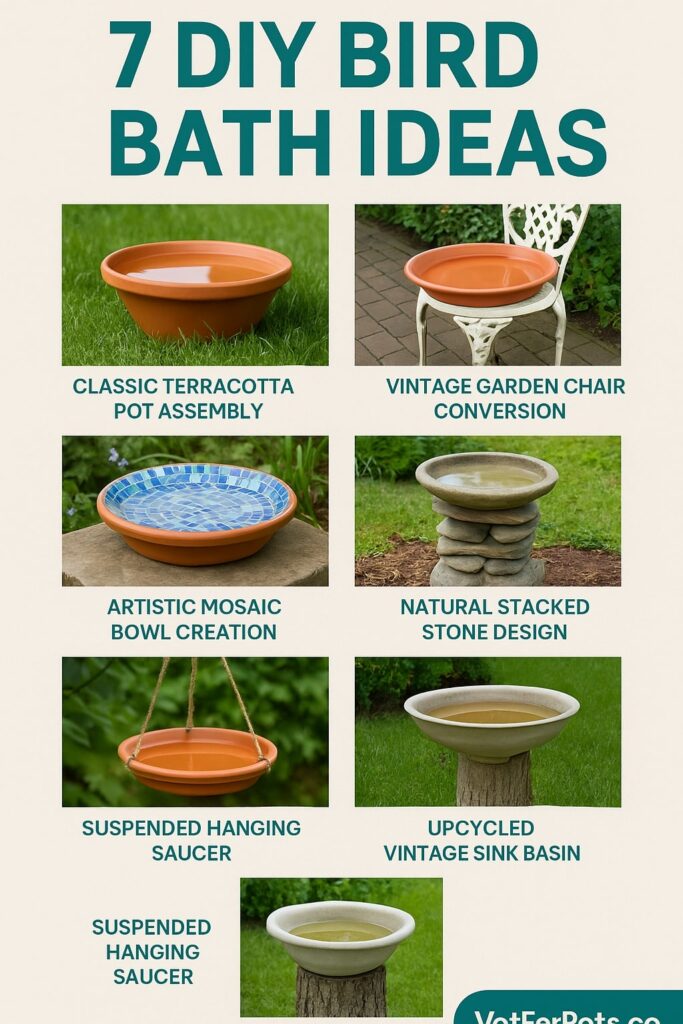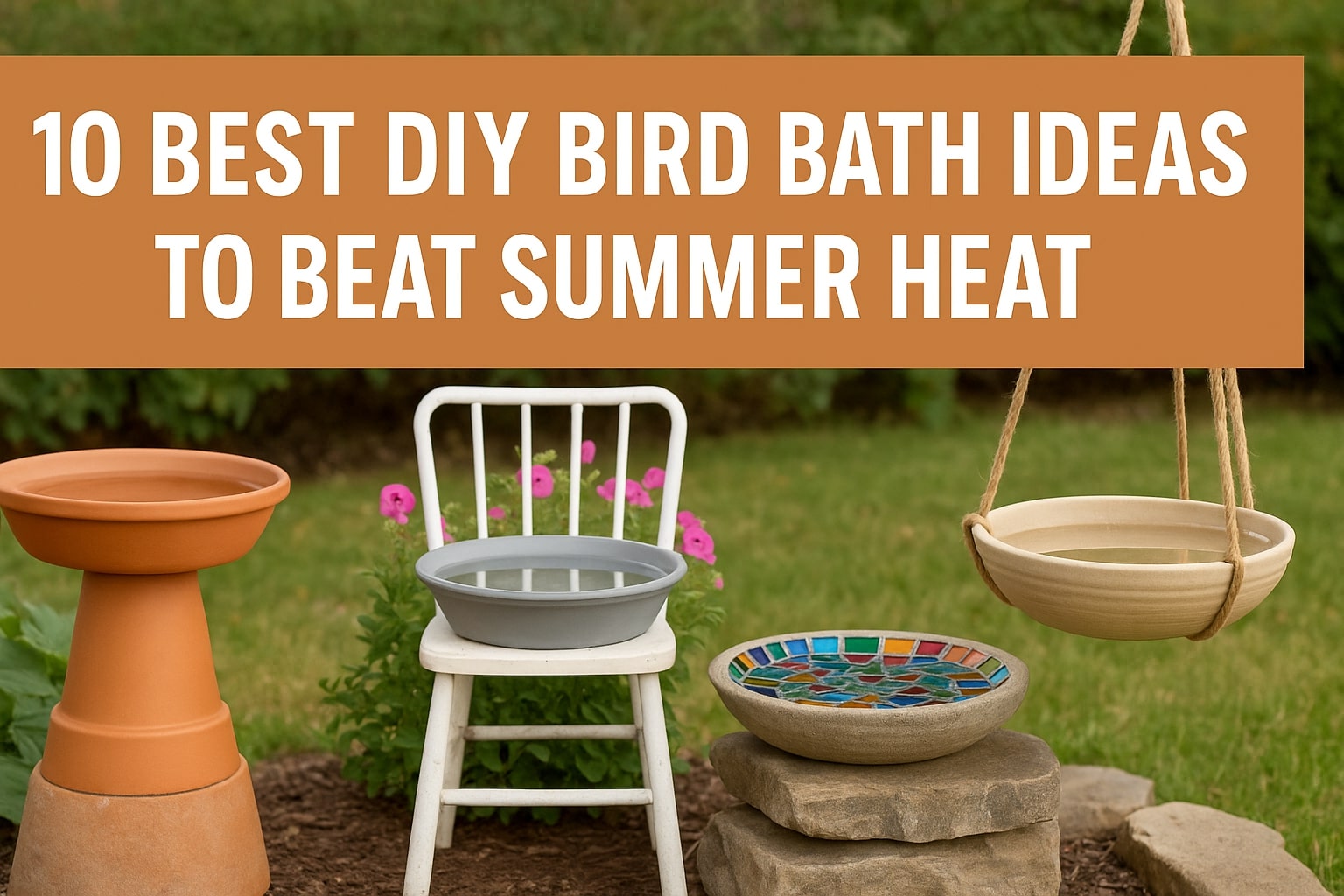Summer brings scorching temperatures that challenge both humans and wildlife, making fresh water sources more critical than ever for our feathered friends. Birds require consistent access to clean water not only for drinking but also for essential bathing behaviors that help them regulate body temperature and maintain healthy plumage.
Creating a DIY bird bath offers an affordable, rewarding way to support local bird populations while adding charm to your outdoor space. Unlike traditional bird feeders that only attract seed-eating species, bird baths welcome a diverse array of birds, including those that primarily consume insects or nectar.
The following ten DIY bird bath projects combine practicality with creativity, ensuring you can provide life-saving relief to birds during the hottest months while crafting something uniquely yours.
Essential Design Principles for Effective Bird Baths
Before diving into specific projects, understanding what makes a bird bath truly functional ensures your DIY efforts will successfully attract and help birds. Expert guidance from Cornell Lab of Ornithology emphasizes that birds prefer shallow water with gentle slopes that allow them to wade gradually into deeper areas. The ideal depth ranges from just one inch at the edges to a maximum of two inches in the center, as birds prefer wading over swimming.
Width matters significantly more than you might expect, with successful bird baths measuring at least 30 centimeters across to accommodate multiple birds and provide adequate space for bathing behaviors.
The basin should feature sloping sides rather than steep drops, creating natural entry points that make birds feel secure. Additionally, incorporating rocks or branches within the water gives birds stable perches for drinking without getting completely wet.
Top 10 DIY Bird Bath Projects
During extreme heat, like in summer, a bird bath will keep your feathered friends cool.
Usually, fountains and other bird bath supplies are expensive and not very durable.
Therefore, I recommend easy, affordable, long-lasting diy bird bath ideas. I’ve got 10 bird bath ideas your pet bird will love:
1. Classic Terracotta Pot Assembly
The terracotta pot bird bath represents one of the most popular and accessible DIY options for good reason. This project requires minimal materials while delivering maximum impact. Start with a large terracotta saucer as your basin, selecting one that measures at least 30 centimeters across for optimal bird accommodation1. Create the base by stacking multiple terracotta pots upside down, varying sizes to achieve your desired height.
Since terracotta is naturally porous, applying a waterproof sealant ensures longevity and prevents water absorption that could lead to cracking during freeze-thaw cycles. Consider painting the completed assembly with outdoor-rated paint for personalization, though earth tones typically blend better with garden environments and may feel less threatening to cautious birds.
2. Vintage Garden Chair Conversion
Transform an unused metal garden chair into a charming bird bath that adds character while serving an important function. This project works best with chairs featuring removable seats or those where the seat can be carefully cut out. Remove the original seat and insert a shallow, appropriately sized saucer or bowl that fits snugly within the chair frame.
The elevation provided by the chair naturally creates the height birds prefer for safety, allowing them to spot potential predators while bathing. Metal chairs offer excellent durability against weather conditions, though you may want to apply the rust-resistant coating to extend the life of your creation.
3. Artistic Mosaic Bowl Creation
Creating a mosaic bird bath transforms a simple terracotta bowl into a stunning garden centerpiece that rivals expensive commercial options. Begin with a plain terracotta bowl and gather mosaic glass pebbles in colors that complement your garden palette. Use waterproof mosaic glue specifically designed for outdoor applications, as standard craft adhesives will deteriorate under weather exposure.
Apply the glass pebbles in your chosen pattern, working in small sections to ensure proper adhesion. After the glue cures completely, apply superfine white grout mixed with waterproof additive to seal the spaces between pebbles.
This combination creates a beautiful, durable surface that withstands temperature fluctuations while providing the shallow, textured bottom birds prefer for secure footing.
4. Natural Stacked Stone Design
For those preferring a completely natural aesthetic, the stacked stone approach requires no purchased materials if you have access to flat stones. Select medium-sized, relatively flat stones of similar dimensions and stack them to create a stable base of appropriate height. The irregular surfaces naturally create the shallow slopes birds find appealing.
Top your stone tower with a shallow dish, large saucer, or even a naturally formed stone depression. This design integrates seamlessly with rock gardens or natural landscaping while providing the functionality birds require. The weight of stacked stones creates excellent stability against wind or larger visiting animals.
5. Suspended Hanging Saucer
Perfect for smaller spaces or locations where ground predators pose concerns, hanging bird baths bring water sources to eye level while creating visual interest. This project requires a sturdy saucer, weather-resistant rope, and a circular support structure such as a twig wreath. Position the saucer within the wreath, then thread rope through three evenly spaced points to ensure balanced suspension.
Hanging installations work particularly well suspended from tree branches or pergola structures, though you must ensure the supporting branch can handle the weight of the filled bath plus visiting birds. Regular checking of rope condition prevents accidents that could harm birds or damage property below.

6. Upcycled Vintage Sink Basin
Large vintage sinks create impressive bird baths with generous capacity for multiple species. Hunt for suitable candidates at salvage yards, estate sales, or online marketplaces where these items often sell for reasonable prices. The built-in drain can be plugged permanently or fitted with a removable stopper for easy cleaning.
Position vintage sinks on stable platforms or pedestals that elevate them to appropriate heights for bird safety. The substantial size accommodates larger bird species while providing enough space for several smaller birds to bathe simultaneously, creating opportunities for diverse bird watching experiences.
7. Simple Serving Bowl Setup
Sometimes the most effective solutions are also the simplest. Large, shallow serving bowls or even cooking pots can become instant bird baths when placed appropriately. Look for containers with the recommended maximum depth of 10 centimeters and widths exceeding 30 centimeters.
This approach works particularly well for testing bird interest in your location before investing time in more elaborate constructions. Position the bowl on an overturned pot or plant stand to achieve proper elevation, ensuring the setup remains stable during use.
8. Miniature Teacup Bath
For those wanting to attract smaller bird species or create charming accent pieces, teacup bird baths offer delightful solutions. This project requires a large teacup and saucer set, strong waterproof adhesive, and materials for creating a stand. Glue the cup and saucer together permanently, then attach to a metal rod or decorative post for appropriate elevation.
While these smaller baths cannot accommodate larger birds, they prove perfect for finches, wrens, and other diminutive species that might feel overwhelmed by larger water sources. Multiple teacup baths placed at varying heights create an engaging display while serving different bird preferences.
9. Inverted Rubbish Bin Design
This ingenious five-minute project demonstrates how everyday items can be repurposed for wildlife benefit. Use a metal rubbish bin with a removable lid, flipping the bin upside down to create a pedestal base. Place the lid upside down on top of the inverted bin, creating an instant shallow basin.
The metallic surface may require modification to prevent slipping, so consider adding a thin layer of sand or small pebbles to provide better footing for visiting birds. This design offers excellent stability and weather resistance while maintaining the proper proportions birds prefer.
10. Tree Stump Natural Platform
Naturally occurring tree stumps provide excellent foundations for bird baths that blend seamlessly with woodland or natural garden settings. Select a stump of appropriate height and level the top surface if necessary. Hollow out a shallow depression or attach a separate basin to create the water-holding area.
This approach works particularly well in established gardens where removing stumps would be expensive or environmentally disruptive. The natural wood appearance attracts birds while providing the stable, elevated platform they need for safe bathing and drinking.
Strategic Placement and Maintenance
Successful bird bath placement requires balancing safety with accessibility. Position your creation in open areas where birds can easily spot approaching predators while avoiding locations with dense vegetation where cats might hide. Regular maintenance proves essential for bird health and bath longevity. Change water daily to prevent bacterial growth and mosquito breeding, while scrubbing the basin weekly removes algae and debris.
Avoid harsh chemical cleaners that might harm birds, opting instead for mild detergents followed by thorough rinsing. During winter months in freezing climates, consider heated bird bath accessories or switch to plastic basins that resist cracking better than ceramic or concrete alternatives.
Conclusion
Creating DIY bird baths offers multiple rewards beyond simply helping local wildlife survive summer heat. These projects provide opportunities for creative expression while contributing meaningfully to ecosystem health and bird conservation efforts. Whether you choose elaborate mosaic designs or simple bowl setups, your DIY bird bath will become a focal point for observing fascinating bird behaviors while providing essential relief during hot weather. Remember that consistency matters more than complexity.
A simple, well-maintained water source will attract more birds than an elaborate bath that receives irregular attention. Start with one project that matches your skill level and available time, then expand your bird bath collection as you discover the joy of supporting your feathered neighbors through the challenging summer months.
- Parrotlets (Personality, Care, Health, Nutrition, & Cost) - June 20, 2025
- Caique (Personality, Care, Health, & Nutrition) - June 20, 2025
- The Complete Guide to Golden Retrievers - June 9, 2025















